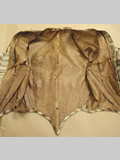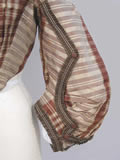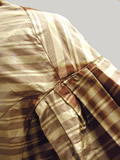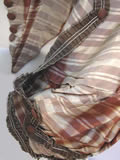This 1860s period bodice is made from light weight beige and rust plaid silk taffeta. It has been trimmed with brown China silk that has been box-pleated to form a ruche. The entire garment is lined with glazed linen. The basic bodice has been sewn by machine (chain stitch), but much of the finish work is by hand. The surface of the garment is in relatively good shape. The flatlining of the bodice is shredding badly although the flat lining inside the sleeves is in much better condition.
| Figure 1: Bodice |
 |
The bodice has a drop shoulder bodice and the shoulder seam drops 2" to the back. The center front is shaped with two darts. The excess dart pickup has been cut away and a channel has been stitched for a bone on each dart. There is a diagonal seam 1 1/2" behind the natural side at the armseye and 2 1/4" at the waist. The back flatlining is in one piece, but the taffeta has curved side back seams that are edge stitched through the flatlining. There is a bone casing and bone at the center back point. The bones are sewn to the seam allowance of the darts which are then clipped to within 1/2" of the bone and whipped closed. The bodice closes center front, right over left, with fabric covered buttons and hand-worked keyhole buttonholes. The center front has two points, vest-style when closed. The neck edge and bottom edge are corded with self-fabric as are the armholes. The seam allowance of the cording is folded under and whipped to the bodice lining, giving it a cleaned edge.
The side seams have been top stitched to the back portion of the bodice which is cut on the fold.
| Figure 2: Bodice Back |
 |
The sleeve has three parts, the upper sleeve, under sleeve and a flat piece bordered with the trim that is held in place with buttons. The sleeve is shaped with pleats at the bend of the arm and at the bottom edge, forcing the sleeve to curve. The bottom edge of the sleeve is corded and faced. There is a box pleat and one knife pleat on either side at the cap, controlling fullness going into the armhole. There are hooks on the inside of the bodice at waist level that were used to attach the bodice to a skirt.
| Figure 3: Sleeve Detail with Buttons |
 |
Trim
The trim on the bodice sleeves consists of a brown box-pleated China silk ruche. The edges have been hemmed in white thread, using a chain stitch machine. The pleats are held in place with two rows of chain stitch. The ruche outlines the decorative piece and covered buttons hold the various points to the sleeve underneath.
The 12 buttonholes along the center front closing are handmade in a keyhole shape. All buttons, on the front closure and as decoration on the sleeves, are covered with self-fabric.
Pattern
The original pattern was on graph paper but it was then xeroxed and the grid lines were lost; the upper left-hand corner provides context. Scale was originally 1/8" = 1". The center back measurement from neck to edge of the garment is 18". No reproduction was created when the garment was researched and the pattern drafted.
The drop shoulder bodice is flatlined with glazed linen. Center front is shaped with two darts. The excess dart pickup has been cut away and a channel has been stitched for a bone on each dart. There is a diagonal seam 1 1/2" behind the natural side at the armseye and 2 1/4" at the waist. The back flatlining is in one piece, but the taffeta has curved side back seams that are edge stitched through the flatlining. There is a bone casing and bone at the center back point. The shoulder seam drops 2" to the back. The bodice closes center front, right over left, with fabric covered buttons and hand-worked buttonholes. The center front has two points, vest-style when closed. The neck edge and bottom edge are corded with self-fabric as are the armholes.
The sleeve has three parts, the upper sleeve, under sleeve and a flat piece bordered with the trim that is held in place with buttons. The sleeve is shaped with pleats at the bend of the arm and at the bottom edge, forcing the sleeve to curve. The bottom edge of the sleeve is corded and faced. There is a box pleat and one knife pleat on either side at the cap, controlling fullness going into the armhole. There are hooks on the inside of the bodice at waist level that were used to attach the bodice to a skirt. Center back of the garment is 18" from neck to bottom edge,
© Erika Malos Kiel, 1997.





